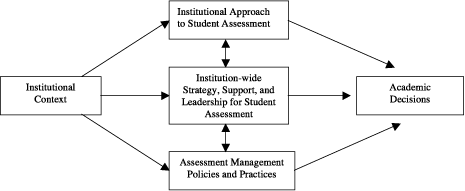Predictors of Institutional Uses of Student Assessment
One of the most important aspects of our national study included an examination of the institutional uses and impacts that have resulted from the increased efforts put forth by institutions to promote and support student assessment. The national survey extended our understanding of how institutions approach, support, and promote undergraduate student assessment as well as the uses of student assessment information for academic decision-making and the institutional impacts that increased assessment has had on institutions. We furthered our examination to include the relationship between an institution’s approaches to, support for, and promotion of student assessment to its uses and impacts of that student assessment information (see Peterson and Augustine, 2000b). The dimensions examined in this analysis (see framework below) are included in the domains of institutional context, institutional approaches to student assessment, institution-wide strategy, support, and leadership for student assessment, management policies and practices for student assessment, and uses and impacts of student assessment. However, institutional attempts to monitor the impacts of student assessment were so limited that we will not examine it.
Conceptual Framework for Predicting Institutional Uses of Student Assessment

Two separate regressions were run using variables from the domains of institutional approach, institution-wide strategy, support, and leadership, and assessment management policies and practices as predictors of the uses of student assessment information in educational decisions and faculty decisions. Each domain contributed to predicting the overall use of student assessment information in both educational and faculty decision. However, the model predicting the use of student assessment information for educational decisions is a significantly better model. A brief overview of the findings regarding the use of student assessment for academic decision-making (i.e. educational and faculty related decisions) is detailed below.
Predictors of Use for Educational Decisions (Model explained 42%
of the variance)
Institutional Approaches to Student Assessment:
- The extent of student assessment done by the institution accounted for 3% of the variance in educational decisions.
- Student-centered methods accounted for 1% of the model variance.
- Number of student assessment studies performed accounted for 17% (the greatest influence) of the model variance.
Institution-wide Strategy, Support, and Leadership for Student Assessment:
- Conducting student assessment for internal improvement was the strongest predictor in this domain accounting for 6% of the total variance in the model.
- Conducting student assessment for state purposes was a significant predictor accounting for 2% of the model variance.
- Conducting student assessment for accreditation purposes was a significant
predictor, however it had a negative influence accounting for 1% of
the model variance.
Assessment Management Policies and Practices:
- Student affairs involvement was the strongest predictor in this domain accounting for 9% of the model variance.
- Linking student assessment to faculty evaluation was the next strongest predictor accounting for 2% of the model variance.
- Access to student assessment information, policies on student involvement
in the assessment process, and supporting student assessment professional
development for administrators, faculty and staff each was significant
and accounted for 1% of the model variance.
Predictors of Use in Faculty Decisions (Model explained 15% of the variance)
Institutional Approaches to Student Assessment:
- Number of student assessment studies performed was the strongest variable in this domain accounting for 4% of the model variance.
- Student-centered methods accounted for 1% of the model variance.
Institution-wide Strategy, Support, and Leadership for Student Assessment:
- Whether an institution had an institution-wide planning group was the only variable in this domain that significantly predicted the use of student assessment information in faculty decisions accounting for just 1% of the model variance. Interestingly, it had a negative influence.
Assessment Management Policies and Practices:
- Linking student assessment to academic planning and review was the strongest overall predictor accounting for 8% of the model variance.
- Linking budget decisions to student assessment results was also significant accounting for 2% of the model variance.
- Providing profession development for student assessment to administrators,
faculty, and staff was a significant predictor in this model accounting
for 1% of the variance.
Predictors of Impacts
- Too limited to examine
